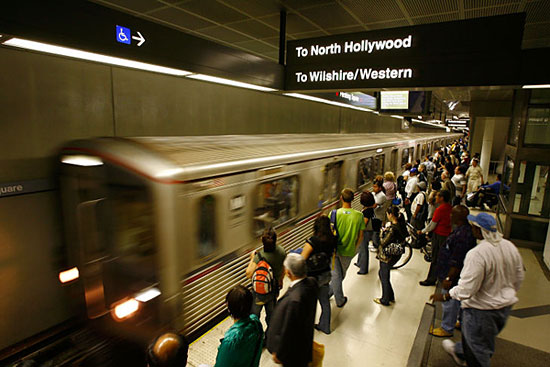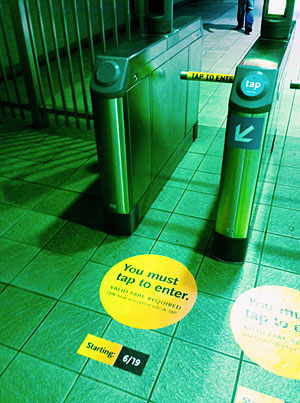End of the road for Metro freeloaders
June 13, 2013

Starting next week, gates on L.A.'s subway system will be locking for good after years of debate and tests.
If you lock it, they will pay.
After extensive testing of latched turnstile gates and rollout of a new TAP card fare payment system, Los Angeles’ long, free trip on a subway without barriers is finally reaching the end of the line.
Next Wednesday, the subway gates at Union Station will be locked as a new era of public transportation rolls out in L.A., following more than two decades on an honor system that critics say unfairly penalizes paying passengers while leaving millions of dollars in revenue on the table.
David Sutton, Metro’s deputy executive officer in charge of the gate-latching project, said the lengthy testing period has been “a real eye-opener,” with consistent results in every test location: fewer boardings but a lot more paying customers using TAP cards.
“The data doesn’t lie,” Sutton said. “When we latch gates, we see less riders, more TAPs, more [vending machine] activity and more revenue.”
In 30 tests at Metro stations conducted earlier this year, sales at ticket vending machines spiked by nearly 30%, with 6,919 additional passengers paying to board trains, compared to the normal volume of paying passengers at each location.
Trains were less crowded because 14% fewer riders got onboard.
And as gate-latching tests intensified and enforcement was heightened, it seemed to create a lingering deterrent to would-be fare beaters. From October through December of 2012, fare evaders made up an estimated 18% of subway riders; from January through April of this year, with testing underway, that number dropped to 13%. So-called “fare checks” by sheriff’s deputies or security officers more than doubled—from 36,588 in October to 74,482 in April. And citations went through the roof, from 881 issued in October to 2,451 in April.
Overall, the testing results suggest that the agency could be able to recover between $6 million and $9 million annually in lost revenue once the subway and existing light rail gates are latched system-wide.
Supervisor and Metro Director Zev Yaroslavsky, a leader in efforts to get the gates latched, has made the case that it’s more than just a matter of money.
“It’s not fair to those people who pay to have a significant percentage of people who don’t pay,” he told the media last month. “The credibility of the enforcement system is undermined. It’s human nature to say, ‘If he’s getting away with it, why should I pay?’ ”

No tap-dancing around it: It will be mandatory to TAP to enter subway gates at Union Station starting Wednesday. Photo/Metro's The Source
It’s been more than 20 years since L.A.’s first subway—the Red Line—opened on an initial stretch of 4.4 miles. And it was five years ago that Metro’s Board of Directors voted to install gates in the subway and some light rail stations, citing security concerns and revenue losses of an estimated $5.5 million a year due to fare evasion.
“Metro remains the only subway operator in the country to operate a barrier-free system,” Yvonne B. Burke, then a Los Angeles County supervisor and Metro board member, said at the time. “That freedom has come at a significant cost to the agency’s bottom line as a result of fare scofflaws.”
Next week’s latching of the first subway gates can be seen as a coming of age moment in the progression of L.A.’s public transit system, which has grown exponentially in recent years and moved from comedian’s punch line to nationally-recognized point of pride.
But getting from there to here has been anything but an express trip when it came to getting the turnstiles locked.
One big stumbling block was the move from paper tickets to the TAP cards needed for passengers to be able to open locked gates. The transition initially prompted widespread confusion and complaints among would-be users, particularly seniors unable to find a way to buy their reduced-priced tickets in the new TAP system. New signs were installed and instructions on vending machine screens were retooled to simplify the process.
Regional transit agencies also needed to be recruited to join the TAP system; by the end of next year, 24 providers will be onboard. Integrating Metrolink passengers’ paper tickets with the TAP system proved to be a special challenge. Eventually, a special chip embedded in Metrolink tickets was developed so that passengers on the commuter rail system can get through locked gates when transferring to a Metro subway or light rail line.
A final test will be run Friday at Union Station, before the Red and Purple lines there are permanently latched on Wednesday, June 19. After that, work will begin on individual subway stations, with locked gates expected to be in place at all Red and Purple line stations by the end of August.
From there, the process moves to the transit system’s light rail stations, which cannot be completely locked because not all of those stations are equipped with gates. Light rail stations with gates on the Gold Line will be latched in October, on the Green Line in December and on the Blue Line in January, 2014.
Metro’s Sutton said the agency has heard some complaints during the lengthy gate-latching testing process but has received far more positive comments, chiefly along the lines of:
“Thank God. Why did you wait so long?”
Posted 6/13/13












 405 bridge work causes a stink
405 bridge work causes a stink

